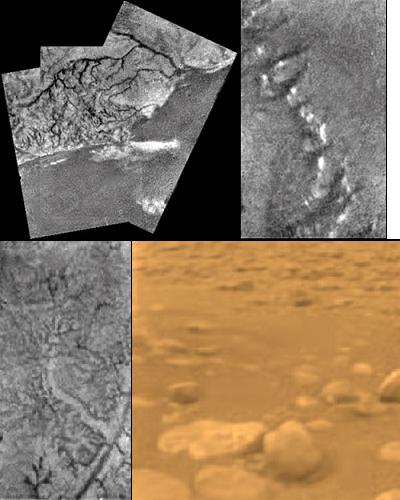The scientists were also able to recover most of the data from the Huygens that was thought to have been lost due to a communication failure
A rain of liquid methane feeds the river channels, lakes, streams and springs on the surface of Saturn's moon Titan. This is shown by a more advanced analysis of the images sent by Huygens. The scientists were also able to recover most of the data from the Huygens that was thought to have been lost due to a communication failure.
As you remember, on January 14, the spacecraft soared through the atmosphere of the moon Titan and transmitted scientific data - including spectacular images to the control room on Earth. The team announced the new results at a press conference held in Paris on Friday.
The liquid was several inches below the surface. Our feeling is that in the area where we landed it rained not long before, says Marty Tomasko, a scientist participating in the project.
"We have evidence that processes on Titan are similar to those that occur on Earth, such as rain, erosion and rubbing of the surface, but the materials in which the process takes place are exotic materials, says Marty Tomasko, a scientist participating in the project and responsible for the Descent Imager Spectral Radiometer device (DISR). The mission scientists revealed that these processes are still happening today. Liquid flowing on Titan's surface caused channels to form between hills made of water ice, as seen in images taken on the moon.
fluid flow
The scientists present at the press conference confirmed that liquid methane (methane is a carbon-based compound, which in chemistry textbooks is called "organic") flows on the surface and is also stored under the surface of Titan. The liquid was several inches below the surface. Our feeling is that it rained at the landing site not long before the landing," said Dr. Tomasco.
"The area where we landed is a typical arid area. The river channels are narrow most of the time. After it rains we have an open flow of liquid. These liquids are stored in temporary ponds and then these ponds dry up and the liquid methane sinks below the surface." Concluded.
Prof. John Zarnecki, principal investigator of the Huygens Project's Surface Science Package (SSP), said the instruments on the spacecraft detected vaporizing methane when the Huygens touched the surface. This leads them to hypothesize that some liquid methane was still on the surface. This methane must be constantly renewed from an unknown source within Titan's soil.”
The dark areas visible in the images are a collection of smog particles dispersed from the haze that covers Titan high above the surface. This dark organic matter is washed in flow channels and collected in basins. It is also possible that this rainfall pattern on Titan is seasonal.
data recovery
The European Space Agency has launched an investigation into the loss of one of the two data channels used to transmit the data from Huygens to Earth via NASA's Cassini spacecraft. It turns out that Cassini did not receive the command to activate the channel. However, the European Space Agency took responsibility for the malfunction. They will now try to reconstruct this data from the recordings of the powerful radio telescopes that listened for signals from Huygens during its descent into Titan's atmosphere and landing on the surface on January 14. The scientists say that they were lucky to land in a scientifically excellent area - at the border between dark matter and light matter.
"I didn't know how to express the feeling of a scientist last week and in the end I decided to quote poetry verses. You must understand, this is a journey of discovery, not just science," said David Southwood, the European Space Agency's scientific director.
The director of the Huygens mission, Jean-Pierre Leverton, said that he would like to send to Titan robotic vehicles like those that NASA sent to Mars.
Huygens was released from its mothership, Cassini, on December 25, 2004. Two and a half weeks later, it entered Titan's atmosphere on January 14 at around 09:05 GMT. Huygens landed on Titan at 11:38 a.m. at a slow speed of 5 meters per second. Cassini continued to receive data from Huygens until 12:50 p.m. when the landing zone dipped below Titan's horizon for Cassini, but the Parkes radio telescope continued to receive data from Huygens until 15:55 p.m. GMT, the scientists said.

